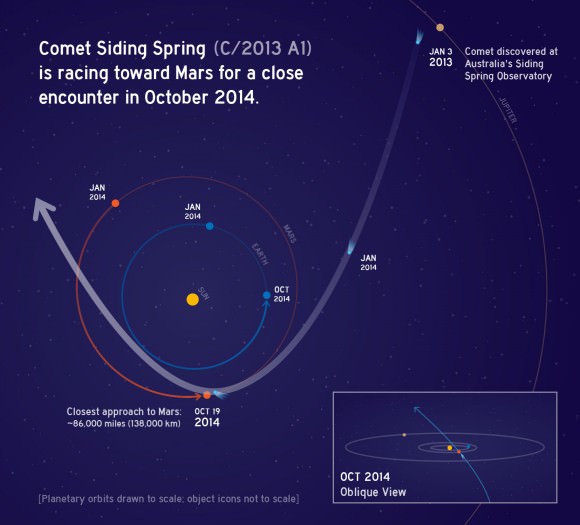One of the big ticket astronomical events of 2014 will be the close passage of Comet C/2013 A1 Siding Spring past the planet Mars in October 2014. Discovered just over a year ago from the Australian-based Siding Spring Observatory, this comet generated a surge of excitement in the astronomical community when it was discovered that it was going to pass very close to the planet Mars in late 2014.
Now, a fleet of spacecraft are poised to study the comet in unprecedented detail. Some of the first space-based observations of the comet have been conducted by NASA’s Hubble Space Telescope and the recently reactivated NEOWISE mission. And although the comet may not look like much yet in the infrared eyes of NEOWISE, its estimated 4 kilometre in diameter nucleus is already active and shedding about 100 kilograms of dust per second.
And although an impact has been since ruled out, it’s that dust that may present a hazard for Mars orbiting spacecraft, as well as a unique scientific observing opportunity.
“Our plans for using spacecraft at Mars to observe Comet A1 Siding Spring will be coordinated with plans for how the orbiters will duck and cover, if we need to do so that,” said NASA/JPL Mars Exploration Program chief scientist Rich Zurek.

Comet A1 Siding Spring is projected to pass within just 138,000 kilometres of Mars on October 19th, 2014. This is one-third the Earth-Moon distance, and 10 times closer than the closest recorded passage of a comet by the Earth, which was Comet D/1770 Lexell in the late 18th century. The comet will also miss the Martian moons of Phobos and Deimos, which have the closest orbits of any moons in the solar system at just 5,989 and 20,063 kilometres above the surface of Mars, respectively.
Assets in orbit around the Red Planet are also slated to observe the close approach and passage of Comet A1 Siding Spring, as well as any extraterrestrial meteor shower that its dust may generate.
“We could learn about the nucleus – its shape, its rotation, whether some areas on its surface are darker than others,” Zurek said in a recent NASA/JPL press release.
The rovers Curiosity and Opportunity are currently active on the surface of Mars. Above in orbit, we’ve got the European Space Agency’s Mars Express, and NASA’s Mars Odyssey and the Mars Reconnaissance Orbiter (MRO). These will be joined by India’s Mars Orbiter Mission and NASA’s Mars Atmosphere and Volatile Evolution (MAVEN) spacecraft just weeks prior to the comet’s passage.
“A third aspect for investigation could be what effect the infalling particles have on the upper atmosphere of Mars,” Zurek said. “They might heat it and expand it, not unlike the effect of a global dust storm.”
Just last year, Mars based spacecraft caught sight of the ill-fated sungrazer Comet C/2012 S1 ISON as it passed Mars. But that dim passage yielded a scant pixel-sized view in the eyes of MRO’s HiRISE camera; Comet A1 Siding Spring will pass 80 times closer than Comet ISON and could yield a view of its nucleus dozens of pixels across.
Though the tenuous Martian atmosphere will shield to surface rovers from any micro-meteoroid impacts, they may also be witness to a surreptitious meteor shower from the debris shed by the comet, a first seen from the surface of another world.
But engineers will also be assessing the potential hazards that said particles may posed to spacecraft orbiting Mars as well.
“It’s way too early for us to know how much of a threat Siding Spring will be to our orbiters,” said JPL’s Mars Exploration Program chief engineer Soren Madsen recently. “It could go either way. It could be a huge deal or it could be nothing – or anything in between.”
In a worst case scenario, Mars orbiting spacecraft would be shuttered and oriented to “shelter in place” as the dust from the comet passes. There’s precedent for this in Earth orbit, as precious assets such as the Hubble Space Telescope were closed for business during the Leonid meteor storm of 1998.
“How active will Siding Spring be in April and May? We’ll be watching that,” Madsen continued. “But if the red alarm starts sounding in May, it would be too late to start planning how to respond. That’s why we’re doing what we’re doing right now.”
Comet A1 Siding Spring was the first comet discovered in 2013 at 7.2 Astronomical Units (AUs) distant. From our Earth based perspective, the comet will reach opposition on August 25th at 0.96 AU from the Earth, and approach 7’ from Mars on October 19th in the constellation Ophiuchus in evening skies. The comet reaches perihelion just 4 days later, and is slated to be a binocular comet around that time shining at magnitude +8.
The comet nucleus itself is moving in a retrograde orbit relative to Mars. Particles from A1 Siding Spring will slam into the atmosphere of Mars — and any spacecraft that happens to be in their way — at a velocity of 56 kilometres per second. For context, the recent January Quadrantids have a more sedate atmospheric impact velocity of 41 kilometres a second.
The unfolding 2014 drama of “Mars versus the Comet” will definitely be worth keeping an eye on… more to come!

